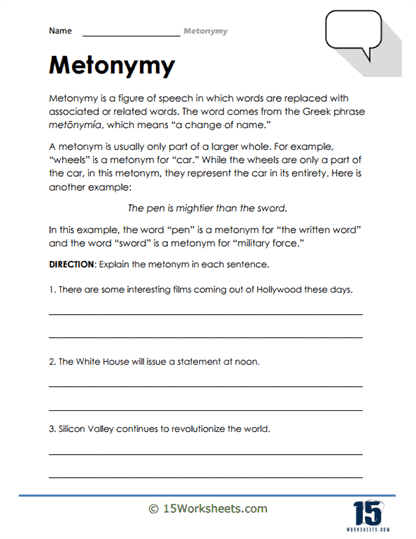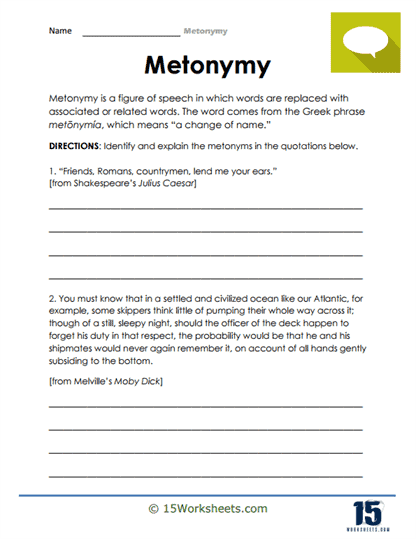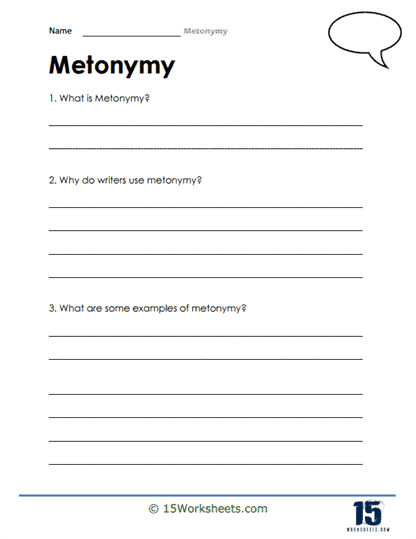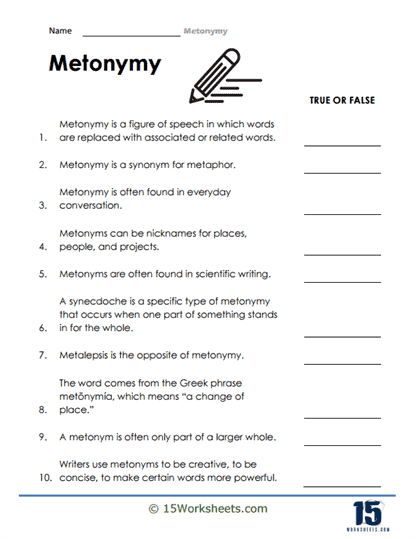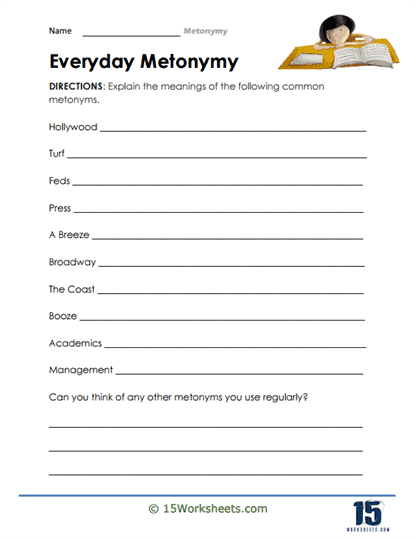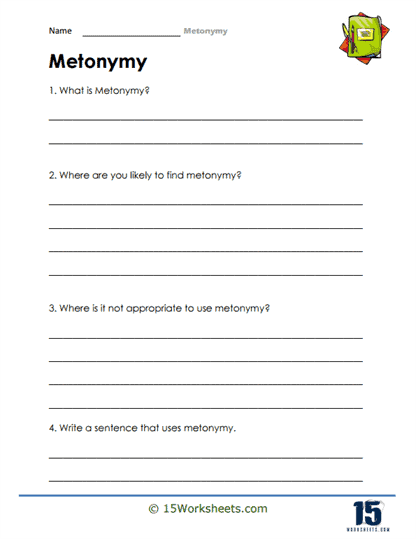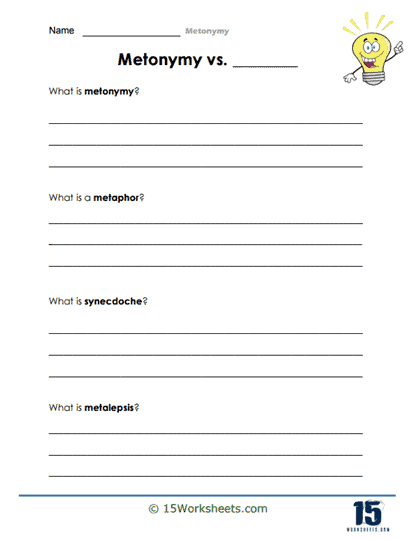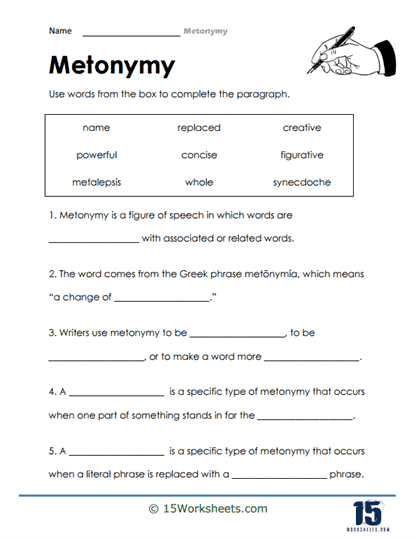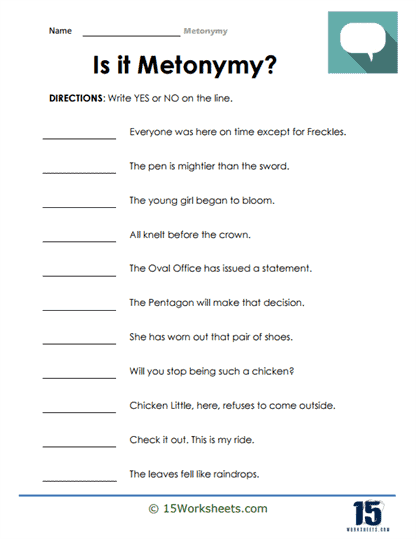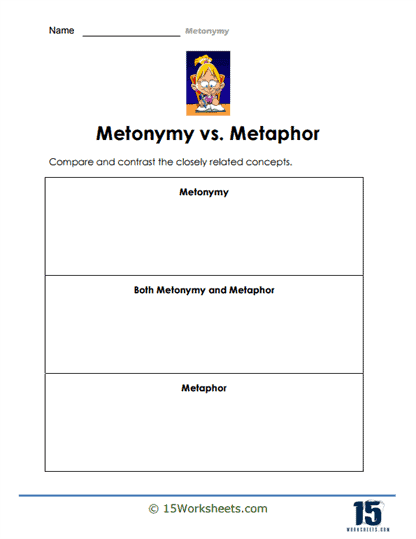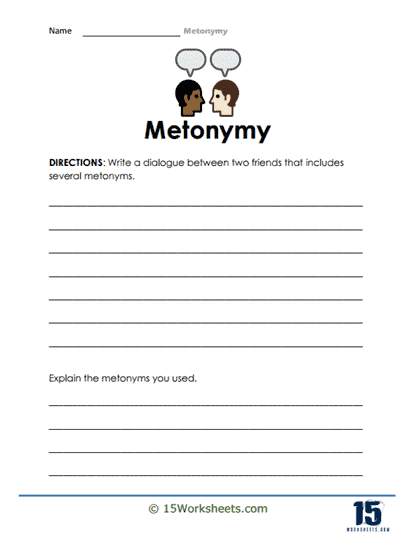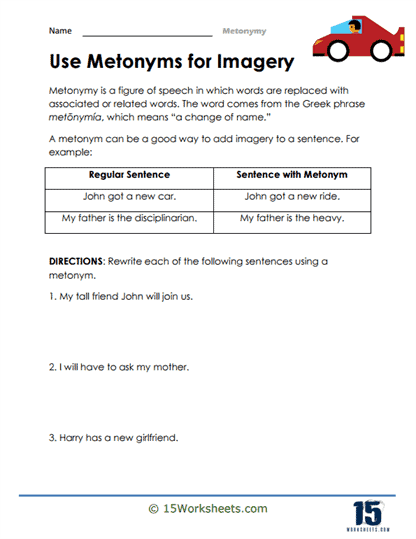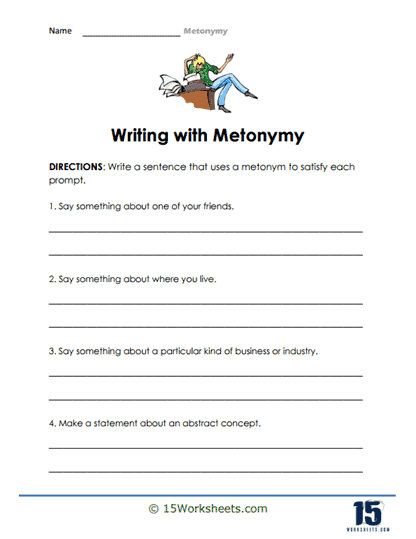Metonymy Worksheets
About These 15 Worksheets
These worksheets are educational tools designed to facilitate learning and mastery of the literary device known as metonymy. Through a variety of exercises, these worksheets engage students in exploring the intricacies of metonymy, enhancing their understanding of language arts and reading skills. This essay will delve into the different types of exercises found on metonymy worksheets, the benefits of practicing with these worksheets, and how they contribute to students’ linguistic and literary proficiency.
Through a variety of exercises that encourage identification, analysis, creation, and application of metonymic expressions, students develop a deeper understanding of language, literature, and the creative possibilities of figurative language. By practicing with metonymy worksheets, students sharpen their vocabulary, improve their reading comprehension, hone their critical thinking and analytical skills, and cultivate their creativity, ultimately becoming more proficient and confident in their linguistic and literary abilities.
Types of Exercises
Identification of Metonymy
One type of exercise found on metonymy worksheets involves identifying instances of metonymy in literary passages or everyday language. Students are presented with sentences or excerpts containing metonymic expressions and are tasked with recognizing and highlighting the substituted terms. This exercise helps students develop the ability to discern metonymic usage in various contexts, enhancing their comprehension of the device and its applications.
Analysis of Metonymic Expressions
Another exercise focuses on analyzing the effectiveness and implications of metonymic expressions within a given text. Students are prompted to examine the relationship between the substituted term and the concept it represents, considering factors such as context, connotation, and cultural significance. Through critical analysis, students gain insight into the nuanced meanings conveyed through metonymy and its impact on literary interpretation.
Creation of Metonymic Expressions
Students may also be encouraged to generate their own metonymic expressions based on specific scenarios or concepts. This exercise fosters creativity and linguistic fluency, challenging students to think abstractly and make connections between different elements of language. By actively constructing metonymic expressions, students deepen their understanding of the device and its potential for conveying complex ideas in concise and evocative ways.
Application in Writing
Metonymy worksheets may include exercises that prompt students to incorporate metonymic expressions into their own writing. Students are tasked with crafting sentences or paragraphs that utilize metonymy to enhance clarity, imagery, or rhetorical effect. This hands-on approach allows students to experiment with metonymic language in a practical context, refining their writing skills and expanding their repertoire of literary techniques.
Interpretation of Metonymy in Literature
Students may be presented with excerpts from literary works that contain metonymic expressions and asked to analyze their significance within the context of the text. This exercise encourages close reading and literary interpretation, as students explore how metonymy contributes to characterization, theme development, or narrative style. By engaging with metonymy in literature, students deepen their appreciation for the artistry of language and gain insights into the creative choices made by authors.
Comparison with Other Literary Devices
Students may also be prompted to compare and contrast metonymy with other literary devices, such as metaphor, synecdoche, or symbolism. This exercise encourages critical thinking and linguistic analysis, as students identify similarities and differences between different forms of figurative language. By examining the distinct characteristics and functions of each device, students enhance their understanding of literary techniques and their applications in writing and interpretation.
Benefits of These Worksheets
Enhances Vocabulary and Language Skills
Practicing with metonymy worksheets exposes students to a wide range of linguistic expressions and encourages them to explore the nuances of language. By engaging with metonymic language in various contexts, students expand their vocabulary, develop their understanding of word relationships, and sharpen their language skills.
Improves Reading Comprehension
Analyzing metonymy in literary passages enhances students’ ability to comprehend and interpret complex texts. By recognizing and interpreting metonymic expressions, students gain insights into the deeper meanings and rhetorical strategies employed by authors, leading to more nuanced and insightful interpretations of literary works.
Fosters Critical Thinking and Analytical Skills
Working with metonymy worksheets encourages students to think critically and analytically about language and literature. By examining the use of metonymy in different contexts, students learn to evaluate the effectiveness of literary techniques, consider alternative interpretations, and make connections between language and meaning.
Encourages Creative Expression
Creating and applying metonymic expressions in writing exercises stimulates students’ creativity and imagination. By experimenting with language and exploring the possibilities of metonymy, students develop their ability to express themselves effectively and convey complex ideas with clarity and precision.
Engaging with metonymy in literature broadens students’ understanding of literary devices and their role in shaping meaning and aesthetic impact. By analyzing how metonymy is used by authors to convey themes, evoke emotions, and create vivid imagery, students deepen their appreciation for the artistry and craftsmanship of literary works.
What is the Literary Device of Metonymy?
Metonymy is a powerful literary device that authors use to evoke imagery, convey complex ideas, and add depth to their writing. This essay explores the definition, characteristics, and examples of metonymy in literature, as well as its effects on readers.
Through the substitution of one term for another based on their associative relationship, metonymy enhances the clarity, conciseness, and evocative power of language in literature. By examining examples of metonymy in literature and its effects on readers, we gain insight into the nuanced and multifaceted nature of this literary device and its role in shaping meaning and interpretation in literary texts.
Metonymy is a figure of speech in which one word or phrase is substituted for another with which it is closely associated. Unlike metaphor, which involves the direct comparison of two unlike things, metonymy relies on the relationship between concepts or objects to convey meaning. Through the use of metonymy, authors can evoke vivid imagery, suggest broader themes, and imbue their writing with layers of complexity.
Main Defining Feature of Metonymy
The main defining feature of metonymy is the substitution of one term for another based on their association or proximity in meaning. Rather than explicitly stating the comparison between two distinct entities, metonymy relies on the inherent connection between them to convey meaning. This association may be based on physical proximity, causality, contiguity, or cultural convention.
Characteristics of Metonymy
Association
Metonymy relies on the associative relationship between two terms, with one term standing in for another based on their shared attributes, functions, or meanings. This association may be direct or indirect, depending on the context and cultural conventions.
Contextual Dependency
The effectiveness of metonymy is heavily dependent on the context in which it is used. The meaning of the substituted term is inferred from the surrounding text or cultural context, allowing readers to interpret the intended association and derive meaning from the metonymic expression.
Evocative Imagery
Metonymy often evokes vivid imagery by substituting a concrete or tangible term for an abstract or intangible concept. By using concrete nouns or objects associated with the abstract concept, authors create sensory-rich descriptions that engage readers’ imagination and enhance the overall impact of the writing.
Economy of Expression
Metonymy enables authors to convey complex ideas or evoke nuanced emotions with brevity and precision. By substituting one term for another with a shared meaning or association, authors streamline their language and eliminate the need for lengthy explanations or descriptions.
Examples of Metonymy in Literature
“The pen is mightier than the sword.”
In this famous expression, “pen” is used as a metonym for writing or literature, while “sword” represents military force or violence. The phrase suggests that the power of words and ideas (represented by the pen) is more influential and enduring than physical force or aggression (represented by the sword). By invoking these symbolic objects, the expression highlights the transformative power of language and the impact of ideas on society.
“The White House issued a statement.”
In this example, “the White House” is used metonymically to refer to the President or the executive branch of the United States government. Rather than explicitly naming the government entity responsible for issuing the statement, the term “White House” is employed to represent the authority and actions of the administration. This metonymic usage reflects the close association between the physical location of the President’s residence and the political power vested in the executive branch.
“The crown announced new tax policies.”
In this sentence, “the crown” serves as a metonym for the monarchy or royal authority. By using the term “crown” to refer to the ruling government or sovereign power, the sentence emphasizes the connection between the symbolic emblem of royalty and the exercise of political authority. This metonymic expression conveys the idea of governmental decree or official pronouncement, highlighting the central role of the monarchy in shaping public policy.
Effect of Metonymy on the Reader
Evoking Imagery and Associations
Metonymy engages readers’ imaginations by evoking vivid imagery and associations between the substituted term and its referent. By relying on familiar or culturally significant associations, metonymy invites readers to make connections between disparate concepts and enriches their understanding of the text.
Enhancing Clarity and Conciseness
Metonymy enhances clarity and conciseness by substituting complex or abstract concepts with concrete or tangible terms. This allows authors to convey meaning more effectively and economize on language, making the text more accessible and engaging for readers.
Suggesting Symbolism and Themes
Metonymy often suggests deeper symbolism and thematic resonance by associating concrete objects or entities with abstract ideas or themes. By employing metonymic expressions, authors imbue their writing with layers of meaning and invite readers to interpret the text on multiple levels, enriching their reading experience.

